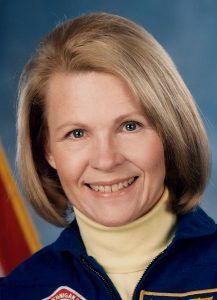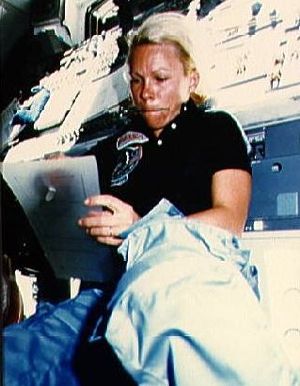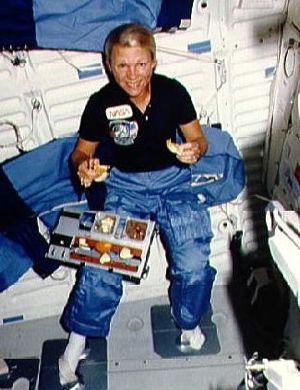
Home - Search - Browse - Alphabetic Index: 0- 1- 2- 3- 4- 5- 6- 7- 8- 9
A- B- C- D- E- F- G- H- I- J- K- L- M- N- O- P- Q- R- S- T- U- V- W- X- Y- Z
Seddon, Margaret Rhea
 Seddon Credit: www.spacefacts.de |
Status: Inactive; Active 1978-1998. Born: 1947-11-08. Spaceflights: 3 . Total time in space: 30.10 days. Birth Place: Murfreesboro, Tennessee.
Seddon had a smooth Tennessee accent. She was seen by other astronauts as a confident, outgoing, always immaculately-dressed surgeon. Later she married Gibson, head of the 'Swine Patrol' - a successful marriage of opposites that mystified everyone. Their first child would be a son, which was rare among astronauts, who seemed to mainly produce girls. After leaving the astronaut corps she became the Chief Medical Officer at the Vanderbilt Medical Group in Nashville.
Official NASA Biography as of June 2016: Margaret Rhea Seddon (M.D.)
NASA Astronaut (former)
PERSONAL DATA: Born November 8, 1947, in Murfreesboro, Tennessee. Married to Former Astronaut Robert L. Gibson of Cooperstown, New York. Three children. Her father, Mr. Edward C. Seddon, resides in Murfreesboro. Her mother, Mrs. Clayton Dann Seddon, is deceased. His mother, Mrs. Paul A. Gibson, resides in Seal Beach, California.
EDUCATION: Graduated from Central High School in Murfreesboro, Tennessee, in 1965; received a bachelor of arts degree in physiology from the University of California, Berkeley, in 1970, and a doctorate of medicine from the University of Tennessee College of Medicine in 1973.
EXPERIENCE: After medical school, Dr. Seddon completed a surgical internship and 3 years of a general surgery residency in Memphis with a particular interest in nutrition in surgery patients. Between the period of her internship and residency, she served as an Emergency Department physician at a number of hospitals in Mississippi and Tennessee, and served in this capacity in the Houston area in her spare time. Dr. Seddon has also performed clinical research into the effects of radiation therapy on nutrition in cancer patients.
NASA EXPERIENCE: Selected as an astronaut candidate by NASA in January 1978, Dr. Seddon became an astronaut in August 1979. Her work at NASA has been in a variety of areas, including Orbiter and payload software, Shuttle Avionics Integration Laboratory, Flight Data File, Shuttle medical kit and checklist, launch and landing rescue helicopter physician, support crew member for STS-6, crew equipment, membership on NASA's Aerospace Medical Advisory Committee, Technical Assistant to the Director of Flight Crew Operations, and crew communicator (CAPCOM) in the Mission Control Center. She was Assistant to the Director of Flight Crew Operations for Shuttle/Mir Payloads. A three-flight veteran with over 722 hours in space, Dr. Seddon was a mission specialist on STS-51D (1985) and STS-40 (1991), and was the payload commander on STS-58 (1993). In September 1996, she was detailed by NASA to Vanderbilt University Medical School in Nashville, Tennessee. She assisted in the preparation of cardiovascular experiments which flew aboard Space Shuttle Columbia on the Neurolab Spacelab flight in April 1998. Dr. Seddon retired from NASA in November 1997. She is now the assistant Chief Medical Officer of the Vanderbilt Medical Group in Nashville, Tennessee.
SPACE FLIGHT EXPERIENCE: STS-51D (Discovery), April 12-19, 1985, was launched from and returned to land at the Kennedy Space Center, Florida. The crew deployed ANIK-C for Telesat of Canada, and Syncom IV-3 for the U.S. Navy. A malfunction in the Syncom spacecraft resulted in the first unscheduled EVA (spacewalk), rendezvous and proximity operations for the Space Shuttle in an attempt to activate the satellite using the Remote Manipulator System. The crew conducted several medical experiments, activated two "Getaway Specials," and filmed experiments with toys in space. In completing her first space flight Dr. Seddon logged 168 hours in space in 109 Earth orbits.
STS-40 (Columbia) Spacelab Life Sciences (SLS-1), June 5-14, 1991, a dedicated space and life sciences mission was launched from the Kennedy Space Center, Florida, and returned to land at Edwards Air Force Base, California. During the nine-day mission the crew performed experiments which explored how humans, animals and cells respond to microgravity and re-adapt to Earth's gravity on return. Other payloads included experiments designed to investigate materials science, plant biology and cosmic radiation, and tests of hardware proposed for the Space Station Freedom Health Maintenance Facility. Mission completed in 146 orbits of the Earth, and logged her an additional 218 hours in space.
STS-58 (Columbia), Spacelab Life Sciences-2, flew October 18 to November 1, 1993. Dr. Seddon was the Payload Commander on this life science research mission which received NASA management recognition as the most successful and efficient Spacelab flown to date. During the fourteen day flight the seven-person crew performed neurovestibular, cardiovascular, cardiopulmonary, metabolic, and musculoskeletal medical experiments on themselves and 48 rats, expanding our knowledge of human and animal physiology both on earth and in space flight. In addition, the crew performed 10 engineering tests aboard the Orbiter Columbia and 9 Extended Duration Orbiter Medical Project experiments. The mission was accomplished in 225 orbits of the Earth in over 336 hours.
NOVEMBER 1998
This is the only version available from NASA. Updates must be sought direct from the above named individual.
NASA Official Biography
- NAME: Margaret Rhea Seddon (M.D.)
- NASA Astronaut
- PERSONAL DATA:
- Born November 8, 1947, in Murfreesboro, Tennessee. Married to Former Astronaut Robert L. Gibson of Cooperstown, New York. Three children. Her father, Mr. Edward C. Seddon, resides in Murfreesboro. Her mother, Mrs. Clayton Dann Seddon, is deceased. His mother, Mrs. Paul A. Gibson, resides in Seal Beach, California.
- EDUCATION:
- Graduated from Central High School in Murfreesboro, Tennessee, in 1965; received a bachelor of arts degree in physiology from the University of California, Berkeley, in 1970, and a doctorate of medicine from the University of Tennessee College of Medicine in 1973.
- EXPERIENCE:
- After medical school, Dr. Seddon completed a surgical internship and 3 years of a general surgery residency in Memphis with a particular interest in nutrition in surgery patients. Between the period of her internship and residency, she served as an Emergency Department physician at a number of hospitals in Mississippi and Tennessee, and now serves in this capacity in the Houston area in her spare time. Dr. Seddon has also performed clinical research into the effects of radiation therapy on nutrition in cancer patients.
- NASA EXPERIENCE:
- Selected as an astronaut candidate by NASA in January 1978, Dr. Seddon became an astronaut in August 1979. Her work at NASA has been in a variety of areas, including Orbiter and payload software, Shuttle Avionics Integration Laboratory, Flight Data File, Shuttle medical kit and checklist, launch and landing rescue helicopter physician, support crew member for STS-6, crew equipment, membership on NASA's Aerospace Medical Advisory Committee, Technical Assistant to the Director of Flight Crew Operations, and spacecraft communicator (CAPCOM) in the Mission Control Center. She currently serves as Assistant to the Director of Flight Crew Operations for Shuttle/Mir Payloads. A three-flight veteran with over 722 hours in space, Dr. Seddon served as a mission specialist on STS 51-D in 1985 and on STS-40 in 1991, and was the payload commander on STS-58 in 1993.
Dr. Seddon made her first space flight aboard STS 51-D, the fourth flight of Discovery and the sixteenth Shuttle mission. Launch was from Kennedy Space Center, Florida, on April 12, 1985. The crew deployed ANIK-C for Telesat of Canada, and Syncom IV-3 for the U.S. Navy. A malfunction in the Syncom spacecraft resulted in the first unscheduled EVA (spacewalk), rendezvous and proximity operations for the Space Shuttle in an attempt to activate the satellite using the Remote Manipulator System. Additionally, the STS-51D crew conducted several medical experiments, activated two "Getaway Specials," and filmed experiments with toys in space. After 168 hours of orbital operations, and 109 orbits of the Earth, Discovery landed on Runway 33 at the Kennedy Space Center on April 19, 1985.
Dr. Seddon next served on the crew of STS-40 Spacelab Life Sciences (SLS-1), a dedicated space and life sciences mission, which launched from the Kennedy Space Center, Florida, on June 5, 1991. SLS-1 was a nine-day mission during which crew members performed experiments which explored how humans, animals and cells respond to microgravity and re-adapt to Earth's gravity on return. Other payloads included experiments designed to investigate materials science, plant biology and cosmic radiation, and tests of hardware proposed for the Space Station Freedom Health Maintenance Facility. Following 146 orbits of the Earth, Columbia and her crew landed at Edwards Air Force Base, California, on June 14, 1991. Completion of this flight logged her an additional 218 hours in space.
On STS-58 Spacelab Life Sciences-2, Dr. Seddon served as Payload Commander on the seven-person life science research mission aboard the Space Shuttle Columbia, launching from the Kennedy Space Center on October 18, 1993, and landing at Edwards Air Force Base on November 1, 1993. This record duration fourteen-day Space Shuttle mission has been recognized by NASA management as the most successful and efficient Spacelab flight that NASA has flown. The crew performed neurovestibular, cardiovascular, cardiopulmonary, metabolic, and musculoskeletal medical experiments on themselves and 48 rats, expanding our knowledge of human and animal physiology both on earth and in space flight. In addition, the crew performed 10 engineering tests aboard the Orbiter Columbia and 9 Extended Duration Orbiter Medical Project experiments. The mission was accomplished in 225 orbits of the Earth in 336 hours, 13 minutes, 01 second.
As of September 1996, Dr. Seddon has been detailed by NASA to Vanderbuilt University Medical School in Nashville, Tennessee. She is assisting in the preparation of cardiovascular experiments which will fly aboard Space Shuttle Columbia on the Neurolab Spacelab flight in 1998.
Characteristics
Departed Date: 1998-02-23. Degree: MD. Marital Status: Married. Children: Three children. Education: UC;Tennessee.
More at: Seddon.
Family: Astronaut. Country: USA. Flights: STS-41-F, STS-51-E, STS-51-D, STS-40, STS-58. Projects: STS. Bibliography: 12, 4457, 5999.
 | STS-51-D Astronaut Rhea Seddon works on flyswatter-like snagging device Credit: NASA |
 | STS-51-D Astronaut Rhea Seddon sits down to a meal in the middeck Credit: NASA |
1947 November 8 - .
- Birth of Dr Margaret Rhea Seddon - . Nation: USA. Related Persons: Seddon. American physician mission specialist astronaut 1978-1998. Physician. Was married to astronaut Robert Lee (Hoot) Gibson. 3 spaceflights, 30.1 days in space. Flew to orbit on STS-51D (1985), STS-40, STS-58..
1978 January 16 - .
- NASA Astronaut Training Group 8 selected. - .
Nation: USA.
Related Persons: Bluford,
Brandenstein,
Buchli,
Coats,
Covey,
Creighton,
Fabian,
Fisher,
Gardner,
Gibson,
Gregory,
Griggs,
Hart,
Hauck,
Hawley,
Hoffman,
Lucid,
McBride,
McNair,
Mullane,
Nagel,
Nelson,
Onizuka,
Resnik,
Ride,
Scobee,
Seddon,
Shaw,
Shriver,
Stewart,
Sullivan.
The group was selected to provide pilot, engineer, and scientist astronauts for space shuttle flights. Recruit women and minorities to introduce diversity into the astronaut corps. Qualifications: Pilots: Bachelor's degree in engineering, biological science, physical science or mathematics. Advanced degree desirable. At least 1,000 flight-hours of pilot-in-command time. Flight test experience desirable. Excellent health. Vision minimum 20/50 uncorrected, correctable to 20/20 vision; maximum sitting blood pressure 140/90. Height between 163 and 193 cm.
Mission Specialists: Bachelor's degree in engineering, biological science, physical science or mathematics and minimum three years of related experience or an advanced degree. Vision minimum 20/150 uncorrected, correctable to 20/20. Maximum sitting blood pressure of 140/90. Height between 150 and 193 cm.. 8,079 applicants, of which half met the basic qualifications. 208 invited for physical tests and interviews. Of the 35 selected, six were women, three were male African-Americans, and one was a male Asian-American.
1984 August - .
- STS-41-F (cancelled) - . Crew: Bobko, Griggs, Hoffman, Seddon, Williams, Donald. Payload: Communications satellites. Nation: USA. Related Persons: Bobko, Griggs, Hoffman, Seddon, Williams, Donald. Program: STS. Flight: STS-41-F. Spacecraft Bus: Shuttle. Spacecraft: Discovery. Planned shuttle mission for deployment of commercial communications satellites. Cancelled due to payload delays..
1985 March - .
- STS-51-E (cancelled) - . Crew: Baudry, Bobko, Garn, Griggs, Hoffman, Seddon, Williams, Donald. Payload: TDRS/IUS. Nation: USA. Related Persons: Baudry, Bobko, Garn, Griggs, Hoffman, Seddon, Williams, Donald. Program: STS. Flight: STS-51-E. Spacecraft Bus: Shuttle. Spacecraft: Challenger. Planned TDRS/IUS deployment shuttle mission. Cancelled due to IUS failure..
1985 April 12 - . 13:59 GMT - . Launch Site: Cape Canaveral. Launch Complex: Cape Canaveral LC39A. Launch Platform: MLP1. LV Family: Shuttle. Launch Vehicle: Space Shuttle.
- STS-51-D - .
Call Sign: Discovery. Crew: Bobko,
Garn,
Griggs,
Hoffman,
Seddon,
Walker,
Williams, Donald.
Payload: Discovery F04 / Anik C1[PAM-D] / Syncom-4 3 /Orbus. Mass: 16,249 kg (35,822 lb). Nation: USA.
Related Persons: Bobko,
Garn,
Griggs,
Hoffman,
Seddon,
Walker,
Williams, Donald.
Agency: NASA Houston.
Program: STS.
Class: Manned.
Type: Manned spaceplane. Flight: STS-51-D.
Spacecraft Bus: Shuttle.
Spacecraft: Discovery.
Duration: 7.00 days. Decay Date: 1985-04-19 . USAF Sat Cat: 15641 . COSPAR: 1985-028A. Apogee: 535 km (332 mi). Perigee: 445 km (276 mi). Inclination: 28.50 deg. Period: 94.40 min.
Manned seven crew. Payloads: Telesat (Canada communications satellite)-I with Payload Assist Module (PAM)-D deployment, Syncom IV-3 communications satellite deploy-ment with its unique stage (unique stage failed to ignite), Continuous Flow Electrophoresis (CFES), Phase Partitioning Experiment (PPE), student experiments, two getaway specials (GAS) Informal science studies (Toys in Space).
1985 April 19 - .
- Landing of STS-51-D - . Return Crew: Bobko, Garn, Griggs, Hoffman, Seddon, Walker, Williams, Donald. Nation: USA. Related Persons: Bobko, Garn, Griggs, Hoffman, Seddon, Walker, Williams, Donald. Program: STS. Flight: STS-51-D. STS-51-D landed at 13:50 GMT. .
1991 June 5 - . 13:24 GMT - . Launch Site: Cape Canaveral. Launch Complex: Cape Canaveral LC39B. Launch Platform: MLP3. LV Family: Shuttle. Launch Vehicle: Space Shuttle.
- STS-40 - .
Call Sign: Columbia. Crew: Bagian,
Gaffney,
Gutierrez,
Hughes-Fulford,
Jernigan,
O Connor,
Seddon.
Payload: Columbia F11 / GBA-2. Mass: 11,767 kg (25,941 lb). Nation: USA.
Related Persons: Bagian,
Gaffney,
Gutierrez,
Hughes-Fulford,
Jernigan,
O Connor,
Seddon.
Agency: NASA Houston.
Program: STS.
Class: Manned.
Type: Manned spaceplane. Flight: STS-40.
Spacecraft Bus: Shuttle.
Spacecraft: Columbia.
Duration: 9.09 days. Decay Date: 1991-06-14 . USAF Sat Cat: 21399 . COSPAR: 1991-040A. Apogee: 296 km (183 mi). Perigee: 287 km (178 mi). Inclination: 39.00 deg. Period: 90.40 min.
Carried Spacelab life sciences module. Payloads: Spacelab Life Sciences (SLS)-1 with long module, getaway special bridge assembly with 12 getaway specials, Physiological Monitoring System (PMS), Urine Monitoring System (UMS), Animal Enclosure Modules (AEM), Middeck Zero-gravity Dynamics Experiment (MODE), 7 Orbiter Experiments Program experiments.
1991 June 14 - .
- Landing of STS-40 - . Return Crew: Bagian, Gaffney, Gutierrez, Hughes-Fulford, Jernigan, O Connor, Seddon. Nation: USA. Related Persons: Bagian, Gaffney, Gutierrez, Hughes-Fulford, Jernigan, O Connor, Seddon. Program: Spacelab. Flight: STS-40. STS-40 landed at 15:40 GMT. .
1993 October 18 - . 14:53 GMT - . Launch Site: Cape Canaveral. Launch Complex: Cape Canaveral LC39B. Launch Platform: MLP1. LV Family: Shuttle. Launch Vehicle: Space Shuttle.
- STS-58 - . Call Sign: Columbia. Crew: Blaha, Fettman, Lucid, McArthur, Searfoss, Seddon, Wolf. Payload: Columbia F15 / EDO. Mass: 10,517 kg (23,186 lb). Nation: USA. Related Persons: Blaha, Fettman, Lucid, McArthur, Searfoss, Seddon, Wolf. Agency: NASA Houston. Program: STS. Class: Manned. Type: Manned spaceplane. Flight: STS-58. Spacecraft Bus: Shuttle. Spacecraft: Columbia. Duration: 14.01 days. Decay Date: 1993-11-01 . USAF Sat Cat: 22869 . COSPAR: 1993-065A. Apogee: 294 km (182 mi). Perigee: 284 km (176 mi). Inclination: 39.00 deg. Period: 90.30 min. Biological, microgravity experiments aboard Spacelab 2. Payloads: Spacelab Life Sciences (SLS) 2, Shuttle Amateur Radio Experiment (SAREX) II..
1993 November 1 - .
- Landing of STS-58 - . Return Crew: Blaha, Fettman, Lucid, McArthur, Searfoss, Seddon, Wolf. Nation: USA. Related Persons: Blaha, Fettman, Lucid, McArthur, Searfoss, Seddon, Wolf. Program: Spacelab. Flight: STS-58. STS-58 landed at 15:05 GMT. .
Back to top of page
Home - Search - Browse - Alphabetic Index: 0- 1- 2- 3- 4- 5- 6- 7- 8- 9
A- B- C- D- E- F- G- H- I- J- K- L- M- N- O- P- Q- R- S- T- U- V- W- X- Y- Z
© 1997-2019 Mark Wade - Contact
© / Conditions for Use